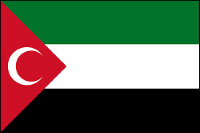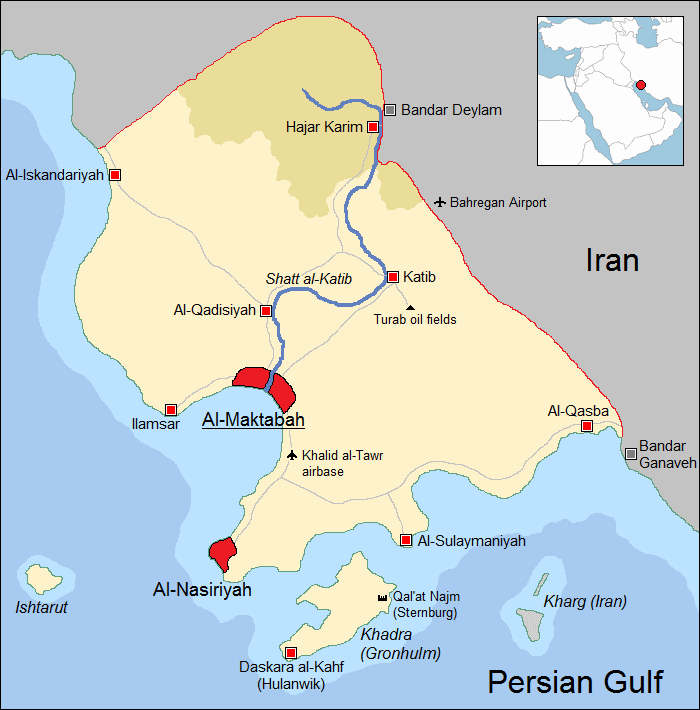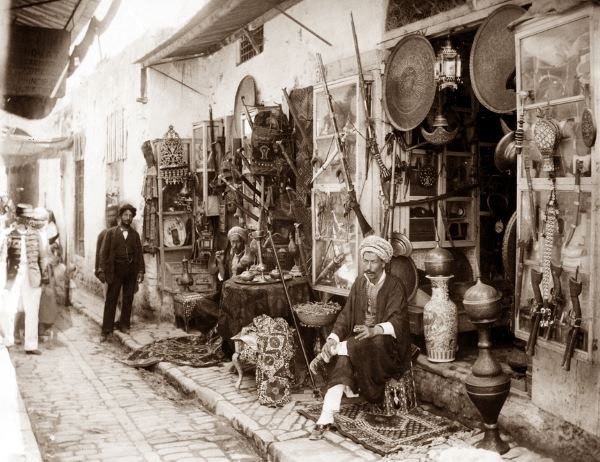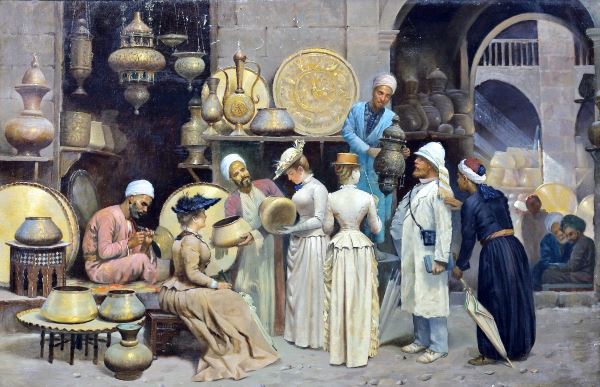  ZawiyahGeneral information  The State of Zawiyah (Dawlat al-Zawiyah, دولة الزاوية) is an emirate in the Persian Gulf, situated between Saudi Arabia, Kuwait, Iraq and Iran. It borders the Iranian province of Bushehr and is about the size of Qatar.
The State of Zawiyah (Dawlat al-Zawiyah, دولة الزاوية) is an emirate in the Persian Gulf, situated between Saudi Arabia, Kuwait, Iraq and Iran. It borders the Iranian province of Bushehr and is about the size of Qatar.The best time to visit Zawiyah is during winter, when temperatures are the most bearable. There are multiple scheduled flights to Al-Maktabah airport, the rest of the country can be reached by bus or by renting a car. Visitors are advised to be well-protected against the sun, bring sufficient water and not to enter the desert without a guide. Basic knowledge of Zawiyan culture is important for a good contact with the local population. Zawiyah  Geography The country has a desert climate. It's warm and dry and there are regular sand storms. The average day temperature is 17° Celcius (63° Fahrenheit) during winter and 48° Celcius (118° Fahrenheit) during summer. Most of the land consists of desert, the north is rocky. The habitable part is limited to the coastline and the banks of the Shatt al-Katib river. Plant life mainly consists of low brushes and date palms. There are many species of insects and reptiles, but also mammals like the Syrian brown bear, wildcat, caracal, striped hyena, jackal, Arabian oryx, marbled polecat and jerboa. Government Zawiyah is a constitutional monarchy (emirate) and the head of state is emir Tariq al-Tawr. There is a parliament, but its authority is limited. The capital is Al-Maktabah, the official languages are Arabic and Persian and the currency is the Zawiyan dinar (1 euro = 0.40 dinar) The country is a member of OPEC and the Arab League. The Zawiyan flag consists of the Pan-Arab colours black, red, white and green. These last three colours are also part of the Iranian flag, which is why both the Arabic and Persian part of the population are represented. The crescent moon symbolizes Islam. Population There are about 3.5 million inhabitants. The population consists of Arabs (55%, of which 20% recent immigrants), Persians (21%), Lurs (7%), Agmar (1%) and migrant workers (16%, mainly from Pakistan, India, Bangladesh, Nepal and the Philippines). Language The universal language in Zawiyah is Arabic, which is spoken by 85% of the population and by 55% as native language. 35% of that speaks the Gulf Arabic dialect. Persian is spoken by 30% of the population and by 23% as native language. 5% of the population speaks Luri, which is related to Persian. 1% speaks the Frilandic dialect Agmarisk and 16% speaks other languages.
Religion 93% of the population is a follower of Islam: 58% of Shia Islam and 35% of Sunni Islam. The other 7% consists of followers of Sufism, Bahá'í, Christianity, Judaism, Zoroastrianism, Hinduism, Ferna Sed and atheism. The Zawiyan government is mainly Shia, but respects the rights of Sunnis and allows them to occupy important positions. Non-muslims are allowed to practise their religion, provided that they do not evangelize. However, religious tolerance is under constant pressure by extremism and tensions between Shias and Sunnis. Furthermore, regular attacks are being committed by two terrorist organizations: the Shia Nur al-Rahim ("Light of the Merciful") and the Sunni Saif al-Itar ("Sword of Vengeance"). Both want to turn Zawiyah into a theocracy based on their own views. Culture Zawiyan culture contains elements from both the Arabic and the Persian world. Internationally, the country is especially known for its architecture, calligraphy, rugs and literature. The people are less proud of the Zawiyan movie industry, which is notorious for its totally crazy action movies filled with unrealistic explosions and bad special effects. The best known director of these kind of movies is Mahmoud Eshraghi. Other well-known Zawiyans are the architect Abdelwahid al-Sayyid and the writer Ahmad Hadid. The national holiday is independence day (June 15). Besides that, Islamic holidays are being celebrated, such as the Sugar Feast (Eid al-Fitr) and the Feast of the Sacrifice (Eid al-Adha). Economy The Zawiyan economy is strongly based on the export of oil and related products, which made the country very rich. Zawiyah is known for its many billionaires, exaggerated luxury and megalomaniac construction projects. To reduce the dependency on oil export, the government is striving for a more diverse economy. For example by stimulating the fishing and technology sector and by making foreign investments. Law enforcement and defence Zawiyah has a combination of Western law and Islamic law (Sharia), in which the latter mainly applies to family law. Besides the regular police force there also used to be a religious police force, but this was abolished in 1995. The Zawiyan military (القوات المسلحة, al-Quwwat al-Musallahah) is small, but modern. The army and air force mainly use American equipment. The navy is equipped with an unknown number of small patrol vessels, eight large patrol vessels and seven fast attack crafts.
History Earliest history The first great civilization in what is now Zawiyah was Elam. The city of Ilamsar, which was then situated at a branch of the Shatt al-Katib, was founded by the Elamites and was called Haltamsari. In the 7th century BC the area was conquered by the Medes, in the 6th century BC by the Persians and in 330 BC by Alexander the Great, who founded Alexandria along the west coast, which was named after him (nowadays Al-Iskandariyah). In the centuries thereafter, the area was ruled by the Seleucids, Parthians and Sassanids. In 641 the area was conquered by the Rashidun Caliphate and converted to Islam. The Rashidun were succeeded by the Umayyads, Abbasids, Mongols, Safavids, Afsharids and Qajars. The Persian name for this region was "Zavieh", which meant "The Angle". This referred to the sharp angle in its coastline. The Arabic translation of this was "al-Zawiyah" (الزاوية), which soon became the most used name. Nasir dynasty In the 18th century Zawiyah was ruled by the Qajar dynasty (Persia). However, a small majority of the population consisted of Arabs, who had settled along the Persian coasts for many centuries and hardly felt a cultural or religious connection with the Qajars. The British Empire, which sought to gain influence in the region, therefore supported the Arab warlord Nasir bin Rashid, who declared Zawiyah independent on February 8, 1828 and granted the British trade concessions in exchange for their support. Persia, which was weak and unstable after the Russo-Persian wars, was unable to do something about it. Nasir bin Rashid chose Al-Maktabah as capital. Under his rule the Arab identity of Zawiyah became increasingly dominant, significantly reducing Persian influence on the country. Gronhulm trading post In 1830 Nasir bin Rashid made an agreement with Friland, which, in exchange for a share of the profit, was allowed to build a trading post on Khadra and thus gain access to markets in the Gulf. Khadra, which means "the Green Island" in Arabic, was translated to "Gronhulm" by the Frilanders. The trading post was named Hulanwik. In the years thereafter many Frilandic colonists settled in Hulanwik and it grew into a small, but wealthy port. In the east of Gronhulm the fortress of Sternburg emerged to defend against a possible Persian invasion. The British Empire was not amused with the Frilandic competition and also founded a trading post: the now lost settlement of Port George on the island of Ishtarut. British protectorate In 1902 Persia, which still claimed Zawiyah, threathened to invade the country. The British Empire then offered tiny Zawiyah to become its protectorate. Emir Sulayman al-Nasir now had to choose between two evils: annexation by Persia, or sharing his power with the British. He chose the latter, which did make Zawiyah lose its independence, but it at least continued to exist. Because of this, Zawiyan history books still portray him in a very positive manner. The emir was also very happy with himself, because he founded a new city at the south coast and named it after himself: Al-Sulaymaniyah. He also renamed the port of Jaborsa after his grandfather Nasir bin Rashid: Al-Nasiriyah. The Agmar The British Empire used its new influence in Zawiyah to actively frustrate trading via Gronhulm. Friland, which no longer made any profit with the trading post because of this, was forced to withdraw. A part of the colonists thereupon left Gronhulm, but many had grown attached to their new residence and continued as a private trading company. These stay-behinds were called "Ahmar" (أَحْمَر), the Arabic word for "red", because they got burnt so easily under the sun. In Frilandic this eventually corrupted to "Agmar". The Agmar however, were no longer under Frilandic protection and had become an easy prey. Emir Sulayman al-Nasir started demanding an increasing amount of their profits, which led to so much discontent that the Agmar refused to pay any longer. The emir then formed a small army of faithful followers and landed on Gronhulm on November 6, 1905.  The Sternburg massacre
The Sternburg massacreThe Agmar had fled the town of Hulanwik and had fortified themselves in the Sternburg with their families. Carpet dealer Gudbrand Stainmerssun, a veteran of the Fourth Frilandic-Hiverian War, had formed a civil militia to defend the fortress. However, the emir had cannons at his disposal and reduced the Sternburg to ruins, after which his men stormed the fortress. Sulayman ordered the public beheading of Gudbrand and then massacred the fort's defenders. A young girl named Albhild Țurisduhter managed to escape and sought help with the British. They blew the whistle on emir Sulayman and allowed the surviving Agmar to return to Hulanwik. Their descendants still live there today. Oil state During the 30's the first oil was discovered in Zawiyah. Large-scale extraction and export of oil began in 1950, with the discovery of the Turab oil fields. Before that, Zawiyah was relatively poor, but the oil brought a sudden, immense wealth: skyscrapers and megamalls mushroomed in Al-Maktabah, gravel roads turned into asphalt motorways and oil sheiks drove around in sports cars and limousines. The wealth wasn't being properly distributed though, because a small elite became excessively rich while the people remained poor. Tawr dynasty On June 15, 1961 Zawiyah regained its independence and the British fully withdrew from the country. The people, who were still very dissatisfied about the unequal distribution of wealth, wanted emir Bashir al-Nasir to leave as well. He refused and the people started a rebellion, which was led by sheik Khalid al-Tawr. Emir Bashir went into exile and sheik Khalid became the new emir. This was the start of the Tawr dynasty, which continues to this day. Emir Khalid made sure that the oil profits would from then on benefit all Zawiyans. He also forged good ties with both Iran and the Arab world. Relations with the US were at first hostile, but have been greatly improved under the current emir, Tariq al-Tawr. These days Zawiyah is one of the richest countries in the world, but it's also being plagued by religious conflicts and terrorism. Settlements: Daskara al-Kahf (دَسْكَرَة الكهف, "Cave Town" / Frilandic: Hulanwik) Emerged in the 19th century as a Frilandic trading post and mainly known for its many caves, in which houses have often been cut out. The resident Agmar minority is mainly of Frilandic origin. Hajar Karim (حَجَر كَرِيم, "Gemstone") This border town has a medieval souq (Arab marketplace), which is often called "The Gemstone" because of its beauty. Also situated here is the monumental Harakat bridge over the Shatt al-Katib, which connects Zawiyah to Iran. Ilamsar (عيلامسار, "Elam City") With its estimated age of four thousand years this is the oldest city of Zawiyah. Near its center are the well-preserved Elamite city ruins of Haltamsari, one of the country's most important tourist attractions. Al-Iskandariyah (الإسكندرية, named after Alexander the Great) Founded in 330 BC by Alexander the Great (Arabic: "Iskandar"), who passed through there during his conquests. The Sunni Djenna mosque is also situated here. Katib (كَثِيب, "Dune") Industrial city with strong ties to the nearby Turab oil fields. It's the hottest and most polluted city in Zawiyah. Al-Maktabah (المكتبة, "The Library") The capital of Zawiyah, where the parliament and the palace of the emir are situated. The city derives its name from the medieval Dhakira library, which possesses a priceless collection of historical books. Al-Maktabah is a mix of old buildings and modern skyscrapers. The most important shopping street is Basra street (شارع البصرة, Sari" al-Basrah), where you will mainly find the more expensive brands. Al-Nasiriyah (الناصرية, named after Nasir bin Rashid) The original name of this city was Jaborsa (جابرسا), but in the early 20th century it was named after Zawiyah's founder. Al-Nasiriyah is the country's second city and is mainly known for its naval base and impressive Hikma mosque. Al-Qadisiyah (القادسيّة, named after the historical Qadisiyah) The name of this town refers to the Battle of Qadisiyah in 636. Its greatest sight is an Elamite ziggurat, dedicated to the god Inshushinak. Al-Qasba (القصبة, "The Citadel") This town has a medieval citadel, which is especially popular among tourists. There are also a Zoroastrian fire temple and a 12th century caravanserai. Al-Sulaymaniyah (السليمانية, named after Sulayman al-Nasir) This modern city full of skyscrapers was founded by emir Sulayman in 1902. Its main sights are the gigantic Fayr palace and the 400 meter (1,312 feet) high Samaa skyscraper. Other locations: Khalid al-Tawr airbase (خالد الثَوْر, named after emir Khalid al-Tawr) The most important base of the Zawiyan air force. Qal'at Najm (قلعة نجم, "Star Fortress" / Frilandic: Sternburg) Ruin of the former Frilandic fortress and site of the 1905 Sternburg massacre. Turab oil fields (تراب, "Soil Fields") These oil fields were discovered in 1950 and have granted huge wealth to Zawiyah. Ishtarut (جزيرة عشتروت, named after Ishtar, goddess of love) (island) Khadra (الجزيرة الخضراء, "The Green Island" / Frilandic: Gronhulm) (island) Shatt al-Katib (شط الكَثِيب, "Stream of Katib") (river)  |

